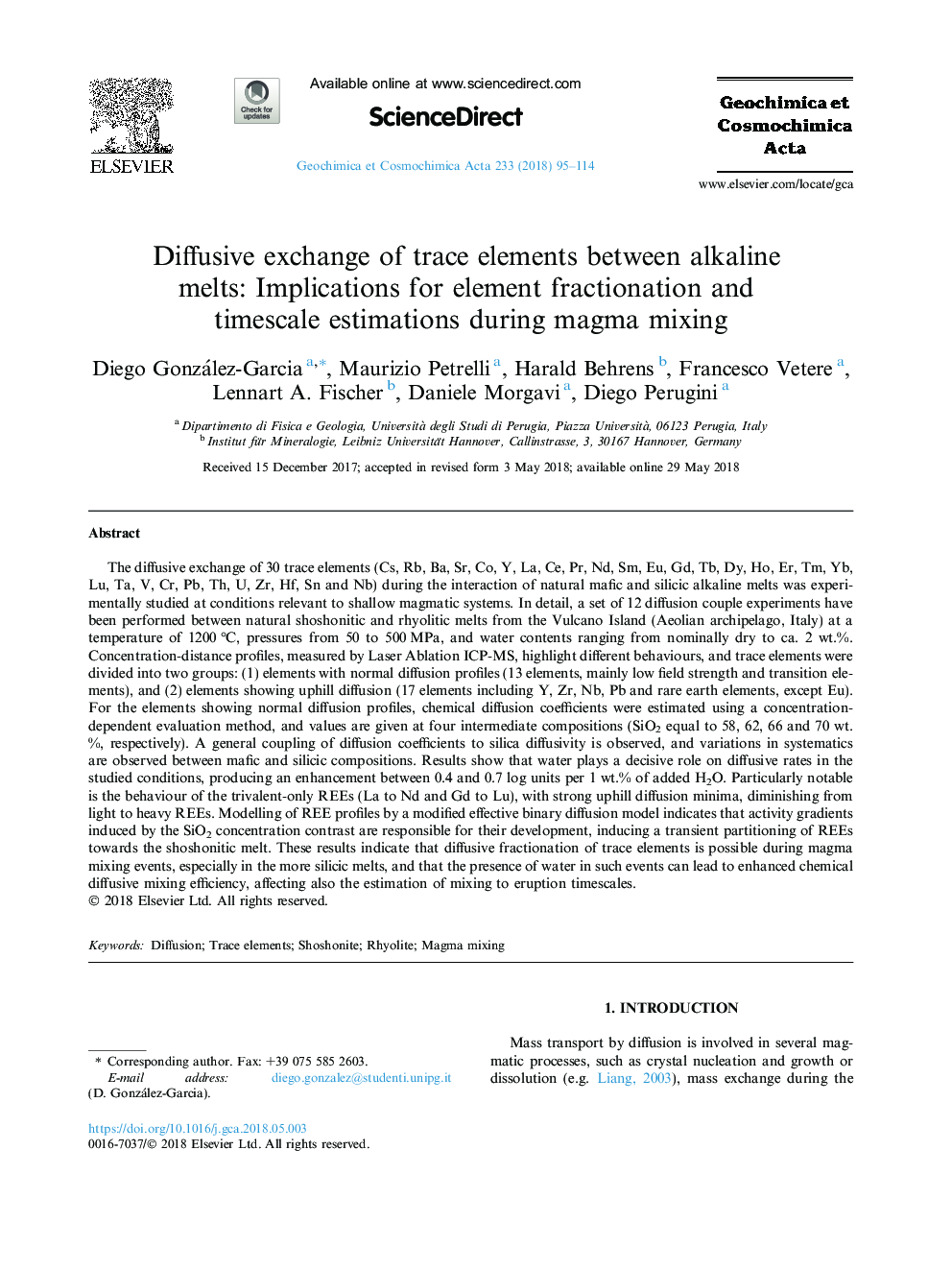| کد مقاله | کد نشریه | سال انتشار | مقاله انگلیسی | نسخه تمام متن |
|---|---|---|---|---|
| 8910713 | 1637924 | 2018 | 20 صفحه PDF | دانلود رایگان |
عنوان انگلیسی مقاله ISI
Diffusive exchange of trace elements between alkaline melts: Implications for element fractionation and timescale estimations during magma mixing
ترجمه فارسی عنوان
تعویض پراکنده عناصر ریز بین قلیایی قلیایی: پیامدهای تقسیم بندی عنصر و تخمین زمانبندی در مخلوط ماگما
دانلود مقاله + سفارش ترجمه
دانلود مقاله ISI انگلیسی
رایگان برای ایرانیان
کلمات کلیدی
نفوذ، عناصر ردیابی، شوشونیت، ریولیت، مخلوط کردن مگا،
موضوعات مرتبط
مهندسی و علوم پایه
علوم زمین و سیارات
ژئوشیمی و پترولوژی
چکیده انگلیسی
The diffusive exchange of 30 trace elements (Cs, Rb, Ba, Sr, Co, Y, La, Ce, Pr, Nd, Sm, Eu, Gd, Tb, Dy, Ho, Er, Tm, Yb, Lu, Ta, V, Cr, Pb, Th, U, Zr, Hf, Sn and Nb) during the interaction of natural mafic and silicic alkaline melts was experimentally studied at conditions relevant to shallow magmatic systems. In detail, a set of 12 diffusion couple experiments have been performed between natural shoshonitic and rhyolitic melts from the Vulcano Island (Aeolian archipelago, Italy) at a temperature of 1200â¯Â°C, pressures from 50 to 500â¯MPa, and water contents ranging from nominally dry to ca. 2 wt.%. Concentration-distance profiles, measured by Laser Ablation ICP-MS, highlight different behaviours, and trace elements were divided into two groups: (1) elements with normal diffusion profiles (13 elements, mainly low field strength and transition elements), and (2) elements showing uphill diffusion (17 elements including Y, Zr, Nb, Pb and rare earth elements, except Eu). For the elements showing normal diffusion profiles, chemical diffusion coefficients were estimated using a concentration-dependent evaluation method, and values are given at four intermediate compositions (SiO2 equal to 58, 62, 66 and 70 wt.%, respectively). A general coupling of diffusion coefficients to silica diffusivity is observed, and variations in systematics are observed between mafic and silicic compositions. Results show that water plays a decisive role on diffusive rates in the studied conditions, producing an enhancement between 0.4 and 0.7 log units per 1 wt.% of added H2O. Particularly notable is the behaviour of the trivalent-only REEs (La to Nd and Gd to Lu), with strong uphill diffusion minima, diminishing from light to heavy REEs. Modelling of REE profiles by a modified effective binary diffusion model indicates that activity gradients induced by the SiO2 concentration contrast are responsible for their development, inducing a transient partitioning of REEs towards the shoshonitic melt. These results indicate that diffusive fractionation of trace elements is possible during magma mixing events, especially in the more silicic melts, and that the presence of water in such events can lead to enhanced chemical diffusive mixing efficiency, affecting also the estimation of mixing to eruption timescales.
ناشر
Database: Elsevier - ScienceDirect (ساینس دایرکت)
Journal: Geochimica et Cosmochimica Acta - Volume 233, 15 July 2018, Pages 95-114
Journal: Geochimica et Cosmochimica Acta - Volume 233, 15 July 2018, Pages 95-114
نویسندگان
Diego González-Garcia, Maurizio Petrelli, Harald Behrens, Francesco Vetere, Lennart A. Fischer, Daniele Morgavi, Diego Perugini,
